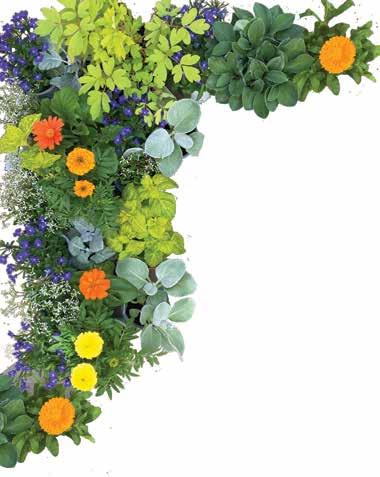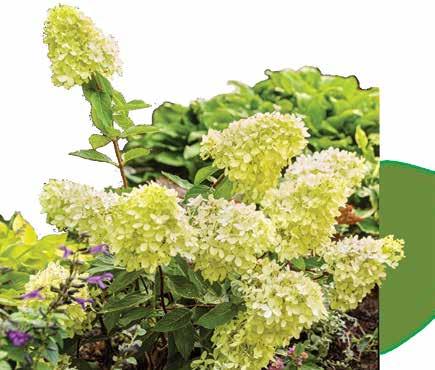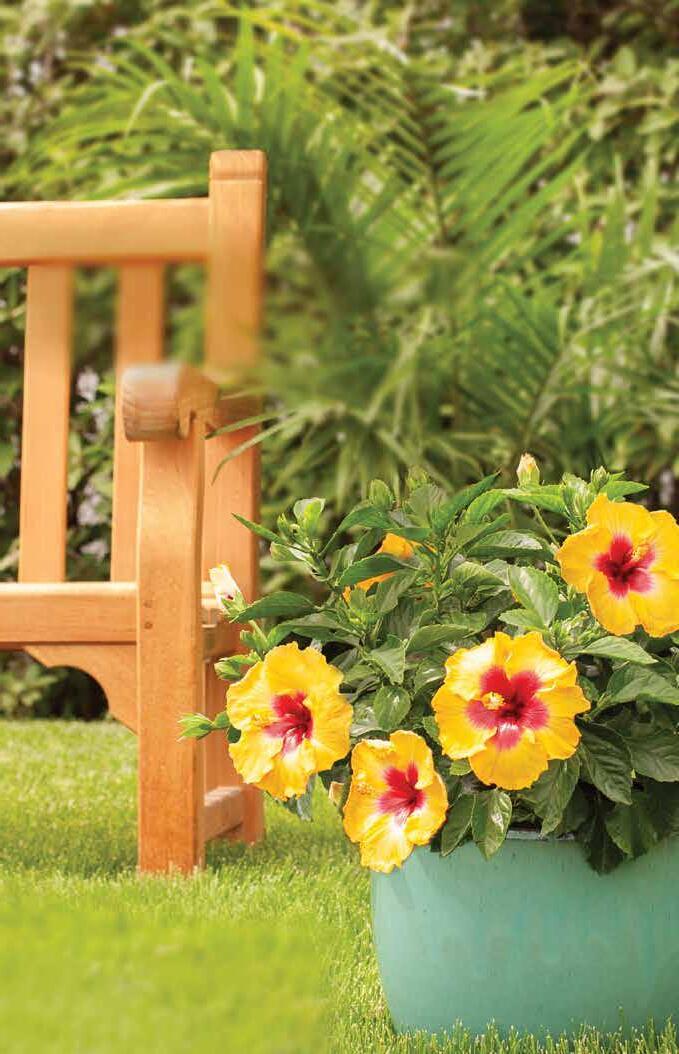
The
Kansas City


Kansas City
Independently owned and operated since 1996
PUBLISHER
Michael Cavanaugh
EDITOR
Elizabeth Cavanaugh
CONTRIBUTORS
Amy Albright
Matt Bunch
Markis Hill
Glenn Hodges
Lenora Larson
Elizabeth McGinley
Anthony Reardon
Anne Wildeboor
DISTRIBUTION
Publishers Delivery Solutions, Inc.
IF YOU WOULD LIKE TO DISTRIBUTE the magazine at your place of business, please contact Mike Cavanaugh at mike@kcgmag.com 913-648-4728
NEED MORE MAGAZINES? mike@kcgmag.com 913-648-4728
CONTACT US P.O. Box 8725 Prairie Village, KS 66208 913-648-4728
ADVERTISING
Mike Cavanaugh at mike@kcgmag.com 913-648-4728
QUESTIONS ABOUT EDITORIAL AND SUBSCRIPTIONS
Elizabeth Cavanaugh elizabeth@kcgmag.com 913-648-4728
HOW TO SUBSCRIBE See details on page 31.
WEBSITE kcgmag.com

The spring awakening has been robust. Not like a full-bodied wine per se, but more akin to a visually striking mural. The early spring-blooming trees (think magnolia, crabapple, redbud, dogwood) have been stunning. Even the Japanese maple that I’ve threatened to remove has performed beyond expectations. The hellebores, daffodils, and lungwort were splendid as well. And the tree peonies never disappoint by having plenty of blossoms to share.
It’s been the time of (re)discovery too. Always heartening to see are the sweet blooms of bleeding heart and columbine. Last year the hosta throughout our landscape were disappointing; it seemed they were stunted somehow. Common belief was drought caused their undersized return. What a pleasant surprise to witness their return to normal size (or so it seems to date).
Then there are the discoveries that make you shout, “Oh my goodness, my clematis and echinacea survived!” Out of the backyard construction site that was once a deck with garden, came two perennials that I thought were certainly gone.
Where all types of ladders, scaffolding, tools and their owners have tread, where there was no sign of anything green, came these two tender plants. Talk about resilience….. I hope your spring returns have been as remarkable.
All of my attention of late has been on the tedious work of cutting back (by hand) the liriope border grass. Since we are without turf, this plant is the durable border of pathways. This task was long overdue, one that is my job when it comes to garden chores. A pair of sharp pruners and a receptacle is all that is needed. Mr. Gardener claims that all he needs to start a gardening project is a shovel and a stick of dynamite. Since the city frowns upon that sort of thing, we’ll save that technique for tougher landscaping locales. (Such a funny guy, my man.)
Also overdue has been a spontaneous garden center visit—to simply pop in, chat with staff and customers. If we left with plants, that would be okay too. We took a road trip to LeRoy, Kan., the home of Arnold’s Prairie Greenhouse & More. We were met by Maggie, an enthusiastic Golden Retriever-turned-Greeter

(pictured with me here) delivering the current issue. We learned that she does this for everyone with no training or incentives. Meeting Maggie and the entire Arnold’s team was surely a highlight that day, along with the plants we couldn’t live without. More about the plants another time. Garden centers offer more than plants. You have access to a collective of knowledge and expertise, as well as the enriching human experience not found on a website. Let’s continue face-to-face encounters. I’ll see you in the garden!




Sometimes if a pond has a lot of algae or weeds the only solution is to treat with chemicals. Before we treat with any kind of chemical we will come out and identify the algae or weed so we can customize your treatment to treat that specific pest. We do biological treatments at the same time as our chemical treatments as these help prevent new blooms of algae or weeds.
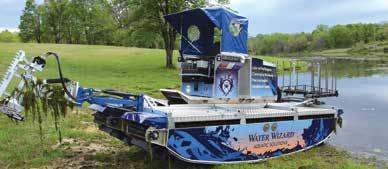
• Clearer Water
• Cleaner Water
• Less Muck
• Help reduce algae and weed growth
• Healthier environment for fish and helps prevent fish kills
• Helps biological and chemical treatments to be more effective!
Our biological treatments are a NATURAL way we help create the perfect pond for you to enjoy without the use of chemicals. Biological products are our first line of defense in the prevention of unwanted pests such as algae, weeds, and muck BEFORE they become a problem. We recommend doing these in the spring before the warmer weather to get the best results and to help in avoiding the use of chemical solutions.
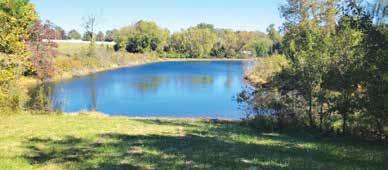
Along with our biological and chemical treatment solutions there may be instances where we would recommend manual removal through the use of a special amphibious machine. By removing the biomass of weeds before applying treatments, we significantly reduce the quantity of chemicals needed. Other cases require application first to make mechanical removal more effective and efficient.
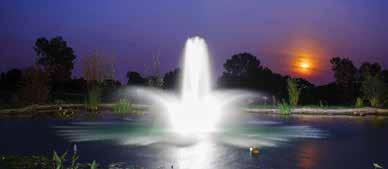
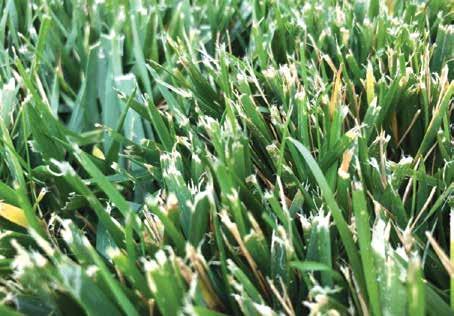
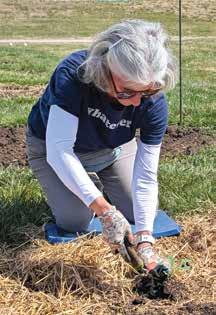
Question: The grass on my lawn looks frayed on the tops. They all look like white or tan colored string on top of the grass. What’s wrong?
Markis’ Answer: The blades on your mower are not sharp enough. Dull blades don’t leave a clean cut. Instead, the blades are ripping the leaf tissue away at high speeds, leaving strands of lignin behind. If the blades were sharper, the cut would appear cleaner.
Question: I just read Markis’ last answer; what is lignin?
Markis’ Answer: Lignin is a complex polymer found in the cell walls of plant cells. This polymer is responsible for adding structure to plants, allowing them to grow tall and support themselves from wind or other environmental stimuli.

Question: I am going plant shopping this weekend. How can I tell if I am choosing the healthiest plant?
Markis’ Answer: Picking plants out at a retailer can be a bit of a challenge. The first sign of a healthy plant is lots of green foliage. This might be hard to tell when the foliage isn’t supposed to be green (i.e., coleus). However, color fading is a similar sign for these types of plants. Another sign of a healthy plant is a large flower potential. You don’t want to buy a perennial flower with only finished blooms. You should pick the plant that has the most unopened flower buds. Lastly, the most significant indicator of a healthy plant is abundant white roots with many root hairs. Removing the plant from the pot and getting a quick glance at the root system before purchase can save you a lot of
headaches. Some retailers don’t like customers tipping the plants upside down and taking them out of the pots, so it is important to be respectful.
Question: It always seems that as soon as summer heat arrives here in KC, it really comes around. Naturally, my vegetable garden then hates this and begins struggling. Is there anything I can do to help it through this phase?
Anthony’s Answer: Much of the heat protection that can be done for your vegetable garden harkens back to the basics of plant care. Remember, a healthy plant is a resilient plant. Ensuring adequate moisture is essential in extreme heat. This entails both the act of watering itself, preferably early in the morning and mulching, as mulch locks in moisture, prevents evaporation, and cools
the soil.
Before these steps, ensure the soil has been properly amended for optimal nutrient absorption, as plants with proper nutrients will recover faster from wilting. Don’t underestimate the power of compost incorporation—it acts like a sponge, assisting in maintaining proper moisture. Also, remember variety selection plays a large role in heat resistance. Especially if you are trying to push one more round of cool season vegetables, heat-and-bolt resistant varieties will be key to successful crops with hotter days nearby.
Question: I tried my hand at seed tape this spring, which was fairly successful! Can I do this with any warm-season crops, too, or is that asking for problems?
Anthony’s Answer: Warm season crops have a few significant differences from cool season, making seed tape significantly less practical. Namely, they are much larger plants requiring much more spacing between sowings, and they have much larger seeds, making them easier just individually to sow.
Is seed tape still possible for the crops? Sure. However, for the sake of time management and not being wasteful, you would often be better off individually sowing during the summer. Also, remember that many warm-season favorites, including tomatoes, peppers, and eggplant, perform better when their seeds are started indoors or purchased as transplants. However, more condensed crops, such as bush beans, okra, and corn, may still be good candidates for using seed tape.
Anthony and Markis are the horticulture agents for Johnson County K-State Research and Extension, each specializing in edible crops and ornamentals, respectively. For free information fact sheets, visit www.johnson. ksu.edu, or call the Extension office at 913-715-7000.

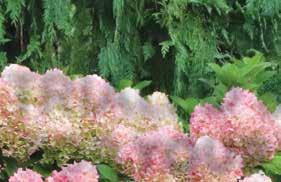



























Drinking water every day is important for our health. Have you noticed drier skin? Do you want to reduce your risk of developing kidney stones, urinary tract infections and constipation? Do you want to reduce your caffeine or sugar consumption? There are so many wonderful benefits of drinking water for our overall health and well-being.
Plain water not your thing? Try flavored water! You can add sliced fruits, vegetables, and herbs to water to enhance the flavor. Try out different combinations to see what you like best.
When it comes to how much water to drink daily, most people recite the 8 x 8 rule. But, do you really need to drink eight 8-ounce glasses, or 64 ounces, of water every day?
About 60 percent of your body is made of water. It plays an important role in keeping all of your body systems working well. Staying well hydrated can help reduce your risk of developing kidney stones, urinary tract infections and constipation.
You lose water throughout the day with normal body processes, such as making urine, having bowel movements and sweating. Very active individuals can lose more water through sweat, as the body tries to cool itself down. The same is true at higher altitudes and when you are out in extreme temperatures. Plus, illnesses such as fever and diarrhea result in additional water loss.


If you lose more water than you take in, your body can become dehydrated. Dehydration can wreak havoc on your body, causing headaches, dizziness or digestion problems. Mild dehydration may impact your mood, memory or how well you’re able to process information. These symptoms often go away once your body gets rehydrated. Medical attention is often needed with severe dehydration, since it can lead to more serious problems such as confusion, kidney failure, heart problems and possibly death. It also is possible to become overhydrated. Although this is not
as common, athletes and individuals with certain medical conditions may be at higher risk for overhydration. Symptoms of severe overhydration are often similar to dehydration and may require medical attention. For example, confusion and seizures can occur. Individuals participating in long stretches of physical activity, such as marathons, often need to replace both water and sodium losses. In these events, a hydration schedule is usually followed, and beverages such as sports drinks may be recommended.
Many factors impact how much water you need, including your age,
sex, activity level and overall health. More water is needed by individuals during pregnancy and while breastfeeding. People with certain health conditions, such as congestive heart failure or renal disease, also have different fluid needs. The same is true for those with serious infections or diarrhea.
Adequate intake levels for water have been determined for generally healthy people and are based on age and sex.
For women, the amount of total water is about 11.5 cups per day and, for men, it’s about 15.5 cups. These estimates, however, include fluids consumed from both foods and beverages, including water. You typically get about 20% of the water you need from the food you eat. Taking that into account, women need about nine cups of fluid per day and men need about 13 cups in order to help replenish the amount of water that is lost.
A quick and easy way to check if you are getting enough water overall is to take a peek at the color of your urine. If you are consuming enough, the urine color will be a pale yellow color. If it is a dark yellow or amber color, you may need to increase the amount you consume.
You can replace water losses and stay hydrated by enjoying a variety of beverages, as well as eating foods that have a high water content, such as fruits and vegetables. For drinks,
Elizabeth McGinley is a Field Specialist in Nutrition and Health Education with the University of Missouri Extension. She offers programming related to healthy eating, physical activity, and overall wellness in the Kansas City area. Email her at emcginley@missouri.edu for more information.
Ways to Increase Water
Listen to your body: If you are thirsty, drink water. This is especially important if you are active or live in a very hot climate.
• Opt for water: Instead of soda or energy drinks, drink a tall glass of water.
• Drink water throughout the day: Consume water with meals, as well as between meals.
• Carry a refillable water bottle: Keep water handy, so it’s there when you want to reach for a drink.
• Add a flavor enhancer: For variety, squeeze some fresh lemon or lime juice into your water, toss in a couple of cucumber slices or add a few fresh basil leaves.
Options with a 90 to 100 percent water content, include:
• Drinks including water, spar-
kling water and fat-free milk
• Fruits, especially cantaloupe, strawberries and watermelon
• Vegetables such as lettuce, cabbage, celery, spinach and cooked squash
Options with a 70% to 89% water content, include:
• Fruits including bananas, grapes, oranges, pears and pineapples
• Vegetables such as carrots, broccoli and avocados
• Dairy products including yogurt, cottage cheese and ricotta cheese
A registered dietitian nutritionist (RDN) can help you estimate your fluid needs. Ask your health care provider for a referral to an RDN. Or, use the Academy’s Find a Nutrition Expert tool to locate an RDN in your area.
https://www.eatright.org/health/ essential-nutrients/water/howmuch-water-do-you-need


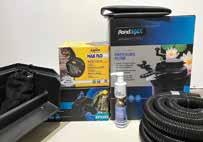



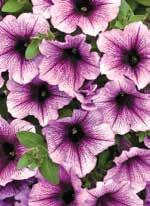
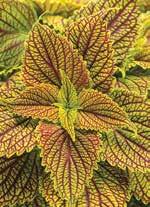
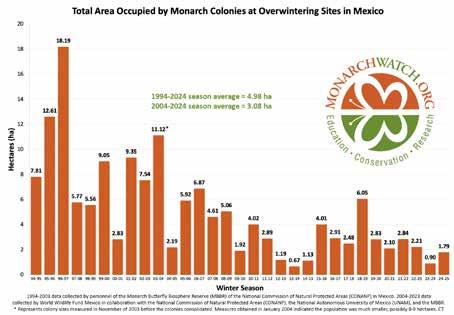
Monarchs are iconic in American popular culture for their beauty and remarkable life story. In early spring, Eastern Monarchs leave their overwintering site near Mexico City to fly north, breeding on Milkweeds for three to four generations across the Midwest and Eastern USA. By late summer they reach as far as southern Canada. This fall “super generation” does not continue breeding. Instead they fly south to their Mexican overwintering site, a journey of up to 3,000 miles. After a brief snooze (“diapause”), the Monarchs begin mating and flying north, initiating the Midwestern breeding cycle as eggs are deposited on Milkweed in Texas and Oklahoma.
Monarch Population Estimates
Rather than counting butterflies one-by-one, Eastern Monarch num-

bers are estimated by measuring the number of hectares covered by roosting Monarchs overwintering in Mexico. The highest recorded count was Winter of 1996-97 with an estimated 380 million Monarchs roosting over 18 hectares (44.5 acres). In 2024, only 2.47 acres were occupied by Monarchs, the second lowest recorded count. The 2025 count was an encouraging uptick to 4.4 acres, but that’s still only 10% of the historic high. A recent study published in the journal Science reported that in only 20 years (2000 to 2020) 22% of USA butterflies have disappeared, with some species declining by 99%. Monarchs are at special risk because of their host, Milkweed, and migratory life style.
In the USA, Monarch Watch estimates that 2.2 million acres of wild-
life habitat are lost to development every year. In addition, farmers now grow glycoside-resistant corn and soybeans and relentlessly spray herbicides on cropland, eliminating all weeds, including Milkweeds, which are the only food for Monarch caterpillars. In addition to herbicides, which also kill necessary nectar plants, all insects are being decimated by uncontrolled insecticide spraying for agriculture and urban spraying for mosquitoes.
Millions of Monarchs don’t survive the perilous southern migration because of habitat loss or weather including drought, which destroys the nectar-rich wild flowers needed to fuel the journey. Even if Monarchs arrive at their winter home near Mexico City, they are not safe because their overwintering site is under siege. Discovered in 1975, no other place has this perfect roosting habitat with Oyamel Fir Trees providing controlled temperatures and humidity. Despite conservation efforts, the Oyamel Fir trees are poached for lumber and destroyed to create avocado plantations. As a species, Monarchs are not necessarily threatened because healthy populations exist world-wide. However, in the United States, migrating Eastern and Western populations have experienced catastrophic declines. The Western migration is at greatest peril and forecast to be extinct by 2080. Can the Monarchs recover?
For decades citizens and scientists have urged the US Fish and Wildlife Services to grant endangered or threatened status to protect Monarchs. The 2014 petition was
finally reviewed in 2024. The mandatory comments period expired in March, 2025 but has been extended to May 19, 2025. If approved, the earliest implementation date is December 2025. Monarch lovers assume that approval will help the Monarchs. Have you read the document? In its current form, Rule 4(d) allows agriculture and landowners to continue destroying Milkweed. AND, conservation and research activities like tagging will be illegal if the organization deals with more than 250 captive Monarchs. Unless an exemption or permit process for Universities and Conservation groups is approved, organizations like Monarch Watch will be prohibited from conducting many of their research activities. Most scientists consider implementation of threatened status to be of little help, and possibly harmful to Monarchs.
If the 4(d) rule passes in its current form, Monarchs will need our help more than ever to survive. Monarchs don’t need words, they need Milkweed and protection from insecticides. Monarch Watch http:// www.monarchwatch.org annually donates millions of regionally-appropriate Milkweed plants to organizations. For individuals, Monarch Waystations provide the best mechanism for massive action. Currently almost 50,000 have been registered in 20 years, but this is not enough milkweed to sustain the migration or even enough to replace the Milkweed lost through spraying. You can sustain hope in the Monarch’s future by promoting Monarch Waystations and donating to Monarch Watch!
Marais des Cygnes Extension Master Gardener, Idalia Butterfly Society and Kansas Native Plant Society member, Lenora Larson gardens and hosts butterflies in the cruel winds and clay soil of Paola, Kansas. She may be contacted at lenora.longlips@gmail.com.















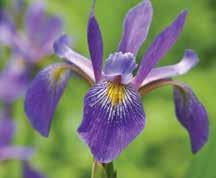
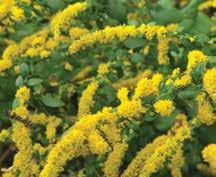
Mt. Cuba Center is a botanical garden in Delaware focused on native plant conservation. The center began 90 years ago as a private garden and has grown into a nonprofit research and education organization that develops native plant cultivars with “exceptional ornamental appeal, garden adaptability, and ecological value.” These are a few of my favorites in order of bloom time.
‘Purple Flame’ blue flag (Iris versicolor ‘Purple Flame’) sets itself apart with eye-catching dark purple foliage that emerges in early spring. Dark stems display showy 3-4” purple flowers with a splash of yellow color above the 2-3’ tall foliage. Blue flag is equally at home in dry and marginal aquatic conditions.

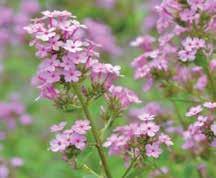
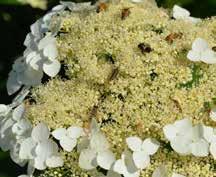
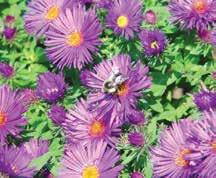

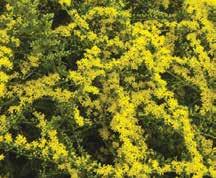
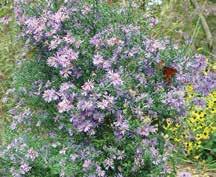
Pair with native cardinal flower (Lobelia cardinalis) and swamp milkweed (Asclepias incarnata) to create a rain garden wildlife oasis in an area with poor drainage.
Tall garden phlox foliage can be prone to powdery mildew. ‘Jeana’ tall garden phlox (Phlox paniculata ‘Jeana’) was discovered growing along a river near Nashville, Tennessee, and is highly rated by the Mt. Cuba Center for its outstanding mildew resistance and shades of fragrant, lavender-pink flowers midsummer through early fall. Plants thrive in moist to average soil in full sun to light shade, and nectar supports butterflies, skippers, hummingbird moths, sphinx moths, and hummingbirds. Expect a flurry of pollinator activity from this 2024
Perennial Plant of the Year!
There are many new hydrangea cultivars of all species on the market these days. ‘Haas’ Halo’ smooth hydrangea (Hydrangea arborescens ‘Haas’ Halo’) is a lacecap hydrangea that stands out from the crowd with giant blooms up to 14” wide on 6-8’ shrubs. Mt. Cuba recommends this selection for both ornamental and pollinator value. Leathery, blue-green foliage provides a lovely backdrop to the large blooms that dry on the plant and remain attractive for months.
Asters host more than 100 species of caterpillars and are an important pollinator plant in late summer and early fall. However, many native asters are simply too large for urban or suburban gardens. Three
Mt. Cuba introductions offer manageable sizes without compromising wildlife value.
‘Bluebird’ aster (Symphyotrichum laeve var. laeve ‘Bluebird’) is a Mt. Cuba selection of the native smooth aster. Growing 24-36” tall, these vase-shaped plants develop clusters of 1-inch blue flowers on arching branches in late summer and early fall. Ranked #1 in Mt. Cuba’s aster evaluations, ‘Bluebird’ is an excellent nectar source for migrating monarchs and other late-season butterflies.
‘Purple Dome’ aster (Symphyotrichum novae-angliae ‘Purple Dome’) is a compact selection growing 1824” tall and producing rich purple mounds of daisy-like blossoms with contrasting yellow centers that pair beautifully with goldenrod.
Amy Albright and her husband, Doug Davison, own Vinland Valley Nursery, a full service organic nursery and greenhouse that includes a huge selection of native plants and features a U-pick flower garden, workshops and a garden shop just south of Lawrence, KS. Their team includes experienced landscapers, plant growers, and artists, including their three daughters who grew up in the business.
‘Snow Flurry’ heath aster (Symphyotrichum ericoides var. prostratum ‘Snow Flurry’) has a compact spreading habit and forms a ground cover with low, arching stems with attractive gray-green foliage that stays below 8”. This cultivar thrives in the sun and adapts to most soils. Frothy white flowers attract butterflies and other pollinators in autumn; it makes a wonderful front-of-border perennial bed edger.
Goldenrod (Solidago) is attractive to bees and butterflies searching for late-season nectar and is especially valuable to migrating monarchs. Used by long- and shorttongued bees, wasps, flies, beetles, butterflies, and caterpillars of many Lepidoptera species, this important nectar source has been wrongly blamed for causing hay fever.
Native goldenrod species can sometimes be too large and aggressive for home gardens. ‘Golden Fleece’ goldenrod (Solidago sphacelata ‘Golden Fleece’) grows sprays of golden yellow flowers that open from mid-August through Septem-
ber over semi-evergreen, heartshaped leaves. This lower-growing 18-24” goldenrod attracts bees and butterflies, particularly hairstreaks, sulphurs, and skippers. Monarchs also rely on goldenrod during their autumn migration. Plants grow best in somewhat fertile, well-drained soils in full sun but tolerate a wide range of conditions. Deadheading will encourage rebloom.
‘Fireworks’ goldenrod (Solidago rugosa ‘Fireworks’) has lacy, radiating bloom spikes of sparkling golden-yellow in autumn. This 3-4’ cultivar makes an excellent backdrop for ‘Bluebird’ aster, coneflowers (Echinacea) and black-eyed Susan (Rudbeckia).
Planting a diversity of native plants provides the most value to pollinators and other wildlife. Flowers that open throughout the seasons and foliage that hosts a variety of insects at different stages of life are essential. Where space is limited, choose plants that offer the most bang for your buck, like these trialed and tested selections from Mt. Cuba Center.



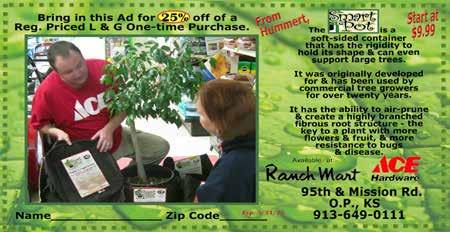

The Garden Club of Shawnee is hosting the ever-popular Garden Sampler Tour. Six gardens have been selected that showcase unique aspects of garden styles—from small pocket patio gardens to large estate lots—tightly groomed landscapes to fields of native flowers and plantings.
Tour tickets are $20 available from Garden Club members as well as via Eventbrite (accessible via the Garden Club’s website at https://gardenclubofshawnee. org/).
See all the tour details at https://gardenclubofshawnee. org/.
Featuring a variety of hardy native trees and perennials, the Ezell’s 1.5 acres have become a haven for birds and other wildlife. Plantings of black-eyed Susan, tall verbena, coneflowers, cosmos and butterfly weed provide a wide swath of gorgeous color across their acreage, and food for their visiting hummingbirds, Eastern bluebirds and variety of butterflies. Additionally, a beautifully landscaped water pond provides a peaceful gathering place.
A certified wildlife habitat since 2010, the Jorgensen’s gardens feature a variety of trees—fruit, magnolias, redbuds, crabapples and a Harry Lauder’s walking stick, to name a few. Additionally, peony bushes number in excess of 20—many are gifts from family and friends. Overlooking an 8-acre pond, their shaded backyard features other favorite plants, such as hydrangea, iris, clematis and several Hosta varieties, and pots of colorful annuals.

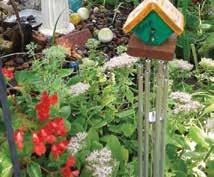
The gardens at Loomis Woods are a 21-year project across the 1-acre lot of the Hinds-Leitch household. Named for the 1930s Merriam housing development and trolley line where their house is set, Hinds and Leitch approach their gardening with equal measures of nostalgia and science. The two are inclined to robust native perennials which mass and naturalize easily and serve pollinators throughout the growing seasons for year-round interest. Their 5000 +/- sq feet of native beds feature more than 75 examples of native flowering perennials, grasses and trees. They have established numerous additional beds and gardens of interest, including street-side daylily and herbal medians, peony and iris, as well as vegetable and herb beds.
A pollinator garden buffet, Gigi’s gardens provide food for pollinators from early spring through the fall season. Although only a few years old, this garden received certification
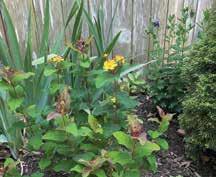

as a Monarch Waystation, as well as a Certified Wildlife Habitat site with the National Wildlife Federation and Kansas Wildlife Federation. Though the garden’s primary focus is on butterflies and caterpillars, it is also a habitat for other pollinators such as bees, birds, and hummingbirds. Not liking to mow, Gigi has transformed their lawn, back and front, into a feast of flowers!
Petite but mighty, the Weishaar garden displays how one can garden vibrantly in a small space! Marlene has filled the areas around her townhome with color and texture, creating a cozy sanctuary for herself and the entertainment of friends. She has carefully selected plants and garden décor items that complement and soften the hardscape of her beautiful open-air patio. Custom touches, such as a Tree of Life patio gate, metal sunflower sculpture on the side of the house, and a corner pergola with handmade lattice to resemble a set of bay windows, provide whimsical

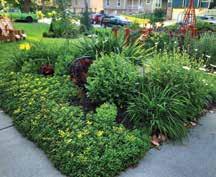
and unique backdrops to clematis and heirloom climbing roses. Visitors will enjoy Marlene’s favorite plants, including bougainvillea, a weeping cherry tree, various alliums, and cotoneaster.
The Wilhoft’s garden is part English cottage and part woodland retreat. The front garden has an English cottage feel with a sun border and fenced potage garden. Curved edges and stones lend a natural look. Native plants and drought tolerant perennials are used throughout, including all kinds of hydrangeas. The backyard is a peaceful woodland retreat with a natural creek and waterfall. Here you will see brunnera, Hostas, Solomon’s seal, Japanese maples and coleus, as well as groundcovers spilling over boulders and rock walls. Additionally, Kate tries to use all the vertical space as much as possible by layering larger shrubs and vines climbing up homemade trellises.

With more than 50 water gardens on display, you will want to mark your calendar and let the “Aquatic Frolic” inspire you.
June 28 Tour #1, Kansas South, I-70 to Louisburg
July 12 Tour #2, Kansas and Missouri North of I-70
July 19 Tour #3, Lawrence, KS, Franklin & Douglas Counties
Aug 2 Tour #4, Jackson County, MO, South of I-70
Aug 9 Tour #5, Cass County
Dive into enchantment at the 32nd annual Greater Kansas City Water Garden Society Tour, themed “Aquatic Frolic.” This summer’s events span 5 Saturdays in June, July, and August, celebrating the wonders of water gardening throughout the metro area. Plein-air artists will again display their unique art at each site. Tickets for all 5 Saturdays are $15 (children under 14 are free) and will be available on Eventbrite beginning May 1, just in time for Mother’s Day giving.

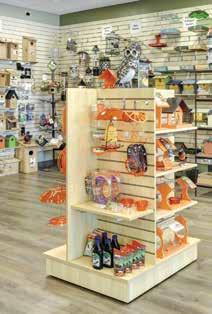





Premium rubber mulch is the eco-friendly alternative to traditional wood mulch for landscaping, playgrounds, and more! Our products insulate the soil while allowing moisture to pass through to plant roots and is non-staining. It doesn’t attract termites or other bugs, mold, or break down.
Never Mulch Again! (816) 241-6400
www.RoosterRubber.com The Greater Kansas City Water Garden Society Presents

“Aquatic Frolic” offers visitors a whimsical adventure featuring lush aquatic blooms, playful Koi, and cascading waterfalls represented in the logo – a fairy at play beside a Koi-filled water garden. Whether you encounter gardens that are formal and symmetrical, natural and serene, or creative and rustic, each space reflects the owners’ dreams and creativity in their own unique landscape.
All proceeds from the tour support our ongoing mission of building and maintaining water features for schools and other nonprofits.

Tickets for all 5 tours are $15. Good for all tour dates and locations. Children under 14 attend free. Purchase tickets through Eventbrite by scanning the QR code, or visit kcwatergardens.com/2025-tour.
More information about the tour is available on the WGS website www.kcwatergardens.com, or on the Water Garden Society of Greater Kansas City Facebook page.
The Water Garden Society gratefully acknowledges our sponsors and advertisers for their support of our annual Water Garden Tour.




THERE ARE GREEN INDUSTRY PROFESSIONALS DEDICATED TO THEIR CRAFT, MADE OBVIOUS BY THEIR CAREER CHOICE. WE ARE CURIOUS ABOUT THE INFLUENCES TOWARD THEIR CAREER, AS WELL AS OTHER INTERESTING ASPECTS OF THEIR LIFE.
Owners: Previously Arnold’s Greenhouse, founded and grown into a regional destination by George and Rita Arnold, new owners Tom and Laura Pavlak created a new name, Arnold’s Prairie Greenhouse and More, and new vision, to both honor the Arnold’s legacy and to seek new possibilities.
Mission statement: Our mission is to offer a wonderful selection of great plants and quality products at reasonable prices, while providing a fun, relaxing and helpful shopping experience. We’re also here to help educate with informative classes and hands-on workshops.
Products/Services: As the hand-painted banner above the greenhouse entrance states, “Welcome to a Gardener’s Paradise!” Inside our huge retail greenhouse, we offer a dazzling array of annuals, perennials, vegetables and herbs, as well as houseplants, aquatic plants, shrubs and trees. The selection includes many native perennials and plant varieties to attract pollinators and hummingbirds. Our garden center is stocked with seeds, fertilizers, pots/containers, potting mixes, tools – most everything you will need to help make your gardening efforts successful. We also enjoy offering many fun and unique items such as garden flags, cute planters and wind spinners, and especially love to offer goods from right here in Kansas. We carry Louisburg Cider Mill apple cider and products, organic and heirloom seeds from Buffalo Seed Company, unique macrame plant hangers (and hanging cat beds!) by RFR Designs (Jessica Underberg) and hand-forged knives and basket hangers by George Arnold.
Tell us about the team: We are blessed by our fantastic team, who make all of this possible. Our core production group of Connie, Bert and Michel
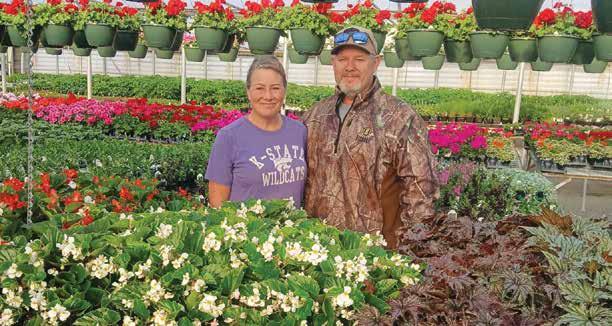
have gone above and beyond this spring! George and Rita Arnold continue to be invaluable with their knowledge, experience and willingness to help. Friendly faces up front are Heather, Janna, Deb and Lacey, with Kent, Pony, Bryan, Kylie and Alex working mostly “behind the scenes.” Horticulture is hard physical work with each day bringing new challenges – we’re so proud of our team for their dedication, flexibility and willingness to jump in where needed. Every member of our team also loves plants and growing things, cares about doing a good job and taking care of our customers. Laura is the “general manager/crazy plant lady” who’s here day in and day out. Tom, who has a “real job” outside the greenhouse, is our resident IT pro, and one of our maintenance guys.
Background and inspiration to work in the green industry: Laura: I think it’s in my blood. My mom has a photo of me when I was only 2 or 3 years old, outside digging up her tulips. I’ve loved plants and nature for as long as I can remember. I graduated from Kansas State University with a Horticulture degree. Over the years, my work has included greenhouse growing, florist, garden center staff, landscape designer, retail clerk, office/ support staff and church administration. What I didn’t realize was that it all was preparing me for this. Also, many customers remember Nancy Brink, who worked for George and Rita for many years – that’s my mom. (Tom: I married a crazy
plant lady and here we are.)
What is trending on the home gardening scene? Color! Gardening is such a great way for folks to express themselves in a unique way, and it’s always fun to see the color combinations our customers put together. Orange and salmoncolored flowers continue to be popular among our customers. Attracting pollinators and hummingbirds. Water-wise and low-maintenance plantings.
What every gardener should know: Sometimes plants die. For those new gardeners/plant owners, don’t be intimidated – jump in, ask questions, don’t be afraid to experiment. I cannot grow an alocasia to save my life, but that doesn’t stop me from trying.
When the work is done, how do you spend your free time? I don’t have much of that these days, but I try to spend time with family, participate in 4-H activities and community events, and we’re always cheering for our K-State Wildcats. Oh, and more gardening!
Contact information: 1430 Hwy. 58, LeRoy, KS 66857. Regular hours: Mon-Sat 9am-6pm, and Sun 1-5pm (subject to change, closed on major holidays). Ph: 620-964-2423; Cell/text: 573682-7193; Email: info@arnoldsgreenhouse.com. Facebook at Arnold’s Prairie Greenhouse & More.

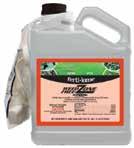



















We have all heard the “April showers bring May flowers” saying, but if your landscape beds are a swamp…will your plants rot? In some cases, plants can’t tolerate wet feet. Some, however, actually prefer soggy conditions, or can handle very wet conditions in short bursts. I have a section in my own yard that is low and when it rains, it’s a pond. When the rain shuts off, it’s the Sahara. Those moisture shifts can be as challenging as the pond scenario.
So, let’s start with the ones that LOVE the moisture.
Queen of the Prairie, or Queen of the Meadow (Filipendula) is a tall perennial with palmate leaves and airy plume flowers. Queen of the Prairie has blush pink blooms, while Queen of the Meadow has white blooms. This back of the border plant can reach heights of 4-7 feet in a growing season, dying back each winter. It does well with consistent moisture and wet feet. It will wilt/ flag if it is too dry, so boggy moist soil is best with full to part sun.
Rose Mallow or Swamp Mallow (Hibiscus moscheutos). This is a perennial hibiscus that is hardy for our zone 6, with some varieties hardy to zone 5. Depending on the variety, they can grow 3-6 feet in a growing season, dying back to the ground each winter. They have tropical looking saucer shaped blooms, ranging in colors white, pink, red, purple and pink. They love our hu-

mid summers and bright full sun. They can tolerate a little shade, but their bloom numbers may decrease. There are some cool new varieties on the market with dark foliage and
Joe Pye Weed (Eupatorium or Eutrochium) is a member of the Aster Family. It can be tall or mid-size depending on the variety. Full sun is best, but can do well in part sun.
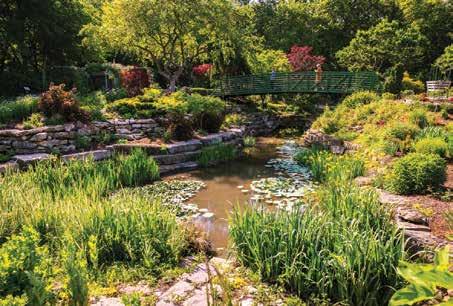
stunning blooms. Check out ‘Dark Mystery’ and ‘Summerific Cookies & Cream’.
Turtlehead (Chelone lyonii) is a late summer blooming perennial, great for part sun/shade and soggy conditions. It’s a member of the Snapdragon family so the blooms have a similar shape, although they are much larger. The pink bloom color is refreshing and fun. They can reach heights of around 3 feet and spread two to three feet. The more moisture, the bigger your clump can get over time.
Ample moisture will keep it the happiest, it will tell you if it’s too dry… wilting and looking sad. Pollinators adore the rosy pink umbel shaped blooms. ‘Little Joe’ is a very wellmannered smaller variety, only getting about 3-4 feet tall.
Cardinal flower (Lobelia cardinalis) boasts vibrant red flowers in late summer, usually August. It prefers a shadier spot in the landscape, but needs consistent moisture. Growing along a pond or streamway can make these perennials very happy. I will say they are not a long-lived pe-
rennial, usually lasting two to three years. The blue variety is very beautiful, but in my opinion very short lived, usually only lasting one growing season. So, plan accordingly, if you know what you are getting from the beginning treat it like an annual and enjoy for as long as it lets you.
Unlike bearded Iris that want dry, very well drained soil, Japanese and Louisiana Iris prefer wet, boggy soil. Iris pseudacorus or the Yellow Flag Iris can be completely submerged in water. Personally, I enjoy the wide, somewhat flatter blooms of the Japanese Iris, with its striking array of color options and combos it’s a true winner.
I have mentioned Red Twig Dogwood (Cornus) in previous articles. It shines in the winter landscape and does great in those soggy spots. Whereas perennials are gone in the winter landscape, this shrub becomes your focal point. I have two flanking my garden shed where it can be soggy. I am not very attentive to them and they do great. ‘Arctic Fire’ is my personal favorite for its tidy shape/ size and its fire engine red branches. Make sure you are pruning out some of those older branches as the color starts to dull. New growth will come and bring you that pop of color you need in your winter garden.
Royal (Osmunda regalis) and Cinnamon (Osmundastrum cinnamomeum) Ferns especially want consistent moisture. If boggy and shady is your current garden bed
(continued on page 18)
Anne Wildeboor, a Kansas State University graduate in Agriculture/Horticulture, has over 20 years of experience in public horticulture, including roles at Powell Gardens and the Overland Park Arboretum & Botanical Gardens. She loves sharing her passion for plants with the public and working alongside dedicated staff and volunteers.
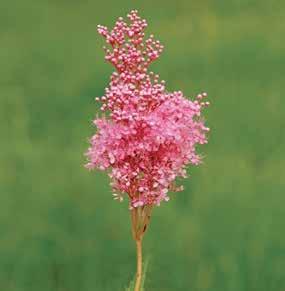
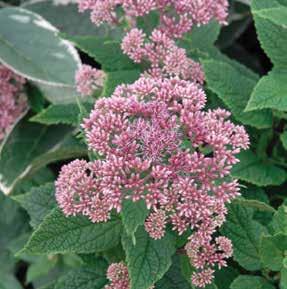

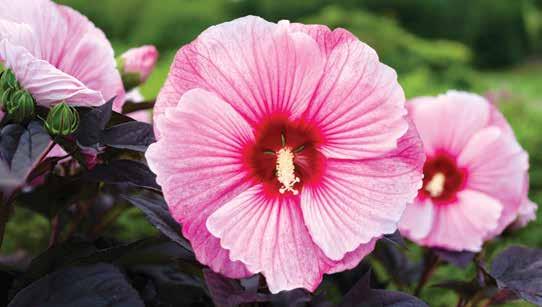

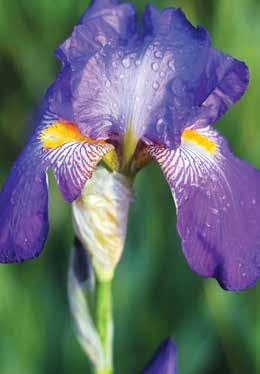
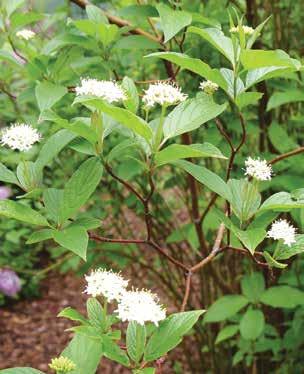
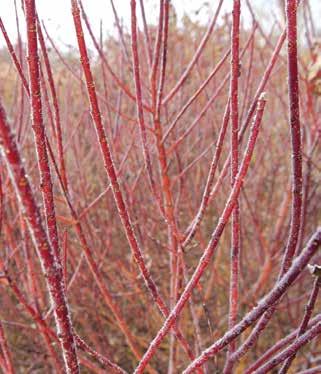
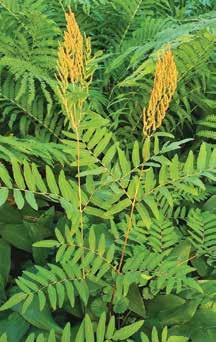
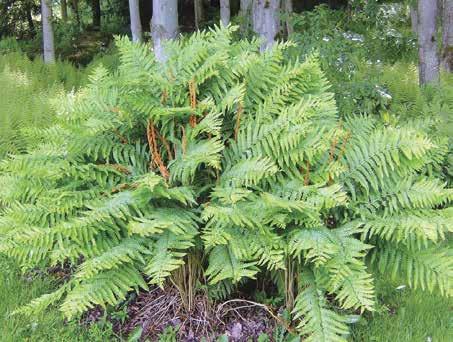
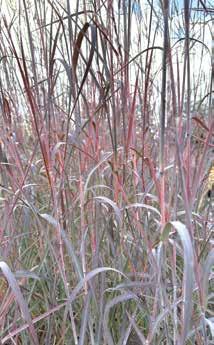
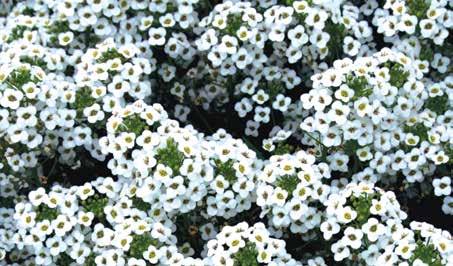
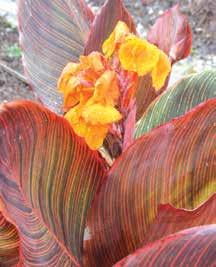

(continued from page 17)
situation, these are for you. The Cinnamon Fern does prefer a richer hummus soil, so make sure you have good organic matter. The cinnamoncolored fronds are a show stopper in the spring. Royal ferns have a bit of an arching, more airy habit, unlike the vase shape habit of an Ostrich Fern. I find them to be an easy and somewhat forgiving fern, as long as they have good moisture.
I will throw a couple annuals in the mix that are lovers of soggy conditions. Lobularia is a low growing, mounding or draping annual. Basically, it is a summer alyssum, that
can take some late spring temperatures then handle the hot summer with ease, as long as it has ample moisture. If it dries out it will drop leaves and look a little scraggly. I love the long season of bloom that it provides and the sweet fragrance that comes with the little cluster of flowers. It’s great in those low front of the border spots or maybe near a sprinkler head or downspout where there is a little extra moisture. I’m trying ‘Easy Breezy Purple’ this summer and of course the industry staple and one of our favorites ‘Snow Princess’ Lobularia.
Canna is the other annual/tropi-
cal that handles ample moisture with ease. Even being completely submerged can work. There are some beautiful varieties that have striking colored foliage with the vibrant blooms. Look for Canna ‘Phasion’ this summer at the Overland Park Arboretum & Botanical Gardens in the Monet Garden. Its burgundy, orangey, pink, green leaves are spectacular. I personally have this situation in my own landscape. A swamp when it rains, but then hard as a rock when the moisture dries up. Here are a few options that will take wet clay soil, but can also handle when that clay hardens and dries out. Big Bluestem
(Andropogon), Pale Purple and Purple Coneflower (Echinacea pallida and purpurea), Ironweed (Vernonia), Rudbeckia, Chokeberry (Aronia), Spiderwort (Tradescantia). I’m going to try Big Bluestem ‘Holy Smokes’ this year. It has purple/pink foliage that is tall and upright, four to six feet.
I know that imperfect soil conditions, light and moisture swings, or extremes can be challenging. I promise you there are plants out there for every situation! Do your research, put the right plant in the right environment and I guarantee you’ll find some success!









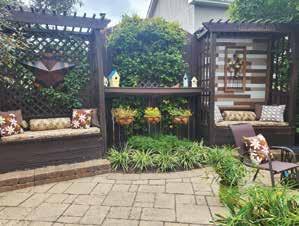


Join MU Extension Master Gardeners of Greater Kansas City for our 2025 Garden Tour. We are featuring seven beautiful gardens in Lee’s Summit. The tour is on June 6 and 7 from 9:00 a.m to 4:00 p.m. Tickets are $20 per person, children twelve and under attend free. Tickets are on sale, both online and at select retailers. Cash and credit purchases are available at select gardens on the tour. Please visit mggkc.org/ourprojects/garden-tour/ for complete details.
Here is a sneak peek of three of the gardens on our tour.
5)
This garden is a perfect example of a private, park-like retreat in a suburban setting. The different foliage textures and hues, surprising pops of color, stone pathways, small flower beds, and unique seating areas provide captivating views in every direction. The garden has been a work in progress, one the garden owner has enjoyed creating for thirty years.
This garden owner has not hesitated to modify the garden plan as the yard matured. Initially the garden was full sun, but as the trees grew, conditions changed. When full sun plants were no longer thriving, they were replaced with shade plants. The garden owner embraces these changes, as part of the art and
enjoyment of gardening.
In the front yard, grass struggled under the canopy of a huge pin oak. The garden owner created a flower bed filled with shade-loving hostas, coral bells, hardy geranium, and blue-eyed grass. The assorted colors and textures create an attractive flowing effect down an otherwise difficult slope to landscape.
The variety of colors, plants, and sitting areas make the garden feel equally private and spacious. Visitors may rest on a bench amongst beautiful flowering bushes, enjoy hobbies in various seating areas, or simply stroll the paths listening to the sounds of nature. The garden has changed over the years, but the peaceful sanctuary created by the garden owner is timeless.
The view from this garden is impressive, and so were the ambitions of this garden owner. Blending the lake view, neighborhood considerations, and conservation were of equal importance. This garden illustrates how careful planning can create a dream landscape that addresses all these goals beautifully.
A mile long view looking toward a dam and two adjacent coves, is just one of the many highlights in this garden space. Mature trees were pruned up to a height that provided privacy, preserved the beauti-
ful view, and maintained a natural habitat for wildlife. In this garden, wildlife is considered cohabitants, and the landscape must be welcoming to all.
Limestone surrounds much of the shoreline. The Property Owners Association has incorporated the same limestone in their hardscaping, piers, and entrance monuments. Natural limestone elements in the retaining walls, and the limestone boulders ensure this garden blends seamlessly with nature and the surrounding aesthetics of the neighborhood. Similarly, river rock, spread close to the shoreline, is the same as the original creek bed below the lake.
This garden owner embraced the challenges of neighborhood and wildlife conservation to create a garden that seamlessly blends plants, trees, and the lake for neighbors of any species. It is a magical space for all to enjoy.
This garden owner loves nature, and believes in working with, not against nature. Understanding the artistic nature of gardening is also important. In this garden, colors and textures unfold like a painted canvas, appearing natural, yet carefully planned. Plants for all seasons, vegetables and herbs mixed in the garden beds, areas of sunlight and
shade, and art pieces are the perfect creative touches in this masterpiece of a garden.
Some of the garden most treasured elements have come from loved ones past and present. The pump used in the pond near the lake came from Granny’s backyard. A sculpture of a little girl with balloons was gifted by the garden owner’s son. A driftwood stump, beloved by a grandson, has now become the home of a beautiful clematis.
The garden owner is also an artist in choosing plants for the microclimate of the different garden areas. Irises that require little dirt, Missouri pickerel keeping dirt from eroding near the shoreline, colorful daylilies in the full sun areas, and hostas in the shade all serve a purpose within the overall picture of the landscape.
Wandering through this landscape offers views of color, texture, variety, purpose, and tradition. Everything is thoughtfully placed yet seems effortlessly in harmony with nature. This garden is truly a work of art.






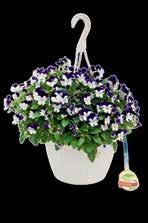
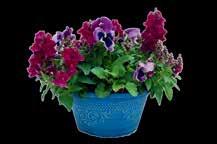










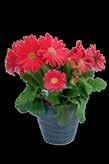






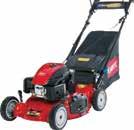










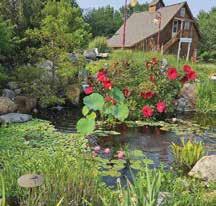

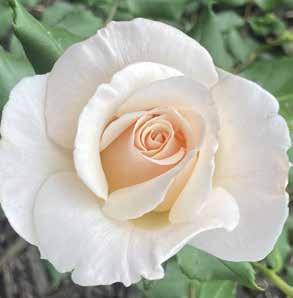

The rose season in the Kansas City area is ushered in by Rosa hugonis and ‘Harison’s Yellow,’ which bloom in late April and early May. The peak spring bloom time for roses in our area is late May. Most modern roses will then repeat bloom every 5 to 7 weeks throughout the summer and fall. Roses are a versatile, multi-stemmed shrub, from low growing and spreading landscape or ground cover roses to stately, upright 6 to 8 foot shrubs. Climbing roses with relaxed canes 6 to 20 feet long supported on a trellis, fence, or other structure can be used to form a floriferous backdrop for a shrub or mixed border, or form a focal point in the garden.
Now is an excellent time to add roses to your garden. Container grown roses are in plentiful supply

at local garden centers. If your roses were not fertilized in April, this should be done now. A second fertilization in late July or early August should be sufficient for most roses. If your roses are susceptible to fungal infection, especially black spot, a regular spray program to suppress fungal growth should be started. Be on the look out for insect pests, aphids, rose slugs, leaf cutter bees, and other pests will start to appear. And, roses need at least one inch of water a week. Supplemental watering may be needed if there is insufficient precipitation.
Further information about rose care can be found at KansasCity RoseSociety.org/rose-care or questions about roses can be sent to RoseHelp@KCRoseSociety.org. These questions will be answered by
American Rose Society accredited Consulting Rosarians, who grow and care for roses in the Kansas City area.
The Kansas City Rose Society will hold its annual Rose Show and Rose Day Festivities on May 31 and June 1 at the Loose Park Garden Center and the Laura Conyers Smith Municipal Rose Garden. If you grow roses, bring your favorite, fresh cut roses at the peak of their beauty or to the Garden Center between 8 a.m. and noon on May 31 to exhibit.
Alternatively, bring your photographs of roses taken at the peak of their beauty. You need to know the name of the roses, but participation is open to anyone and is free. Help will be available to enter your roses
and photographs in the show. The entries will be judged that afternoon. Complete guidelines for the show are posted at KansasCityRose Society.org. The show will be open to the public the afternoon of June 1, at which time the public will be asked to vote on the most fragrant rose. There will be fun activities and music in the Rose Garden. All Rose Day activities are free. Please visit KansasCityRoseSociety.org for further details.

Glenn is an Extension Master Gardener in Johnson County, KS, an American Rose Society (ARS) Master Rosarian, and an ARS Accredited Horticulture Judge. He has been growing roses in Lenexa, KS since 1974 and successfully exhibiting roses since 1998.
•

June 6 and 7
9:00 am – 4:00 pm
Lee’s Summit, MO
$20 per person
Children 12 and under attend free
For ticket info please visit mggkc.org/our-projects/garden-tour/
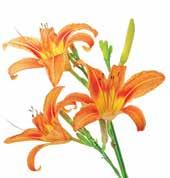




Annual flowers • Perennials • Vegetable starters • Herbs
Shrubs & trees • House plants • Large variety of bulbs
Large selection of pottery • Re-potting service Microgreens & seeds
436 W. 85th St., Kansas City, MO 816-444-7661
waldogreenhousekc@gmail.com facebook.com/waldogreenhousekc
• woodpeckers, starlings, pigeons, sparrows and geese






From trees and shrubs to perennials, mulch and stone, expert Landscape Designers are ready to help with your next project! Call for an At-Home Consultation.








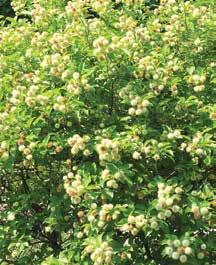
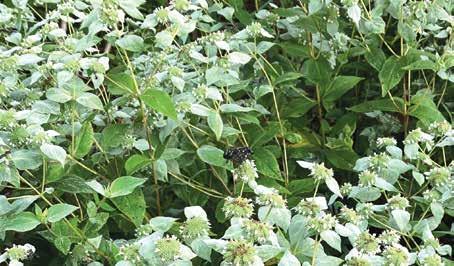
If you follow the adventure of this column, you know that last time we talked about fruit pests in the orchard. Basically, if you plant it, they will come. An apple tree will draw an egg laying codling moth the way milkweed draws a monarch butterfly. Using this analogy, and understanding that an insect has to eat, how do we introduce “good” bugs into the garden and orchard to help with pest management?
We all have some familiarity with bad bugs. Bed bugs, fleas, and mosquitos are major human pests. In the garden and orchard, there are Japanese beetles, squash bugs, spider mites, aphids, etc., that we also classify as “bad.” Bad is, of course, subjective, and anthropocentric. Heck, the bumper sticker philosophy of “the only good bug is a dead bug” is alive and well. In the garden, the “bad” designation goes to fruit eaters, sap suckers, leaf chewers, trunk borers; the insects that kill, weaken, disfigure, and ruin our harvests and

our plants. If those are bad bugs, then there must be…
What is a beneficial insect? Of course, we think of pollinators, those that help ensure fruits in our gardens. There are those that get the limelight (honeybees and butterflies) while hundreds of other species, like bee-flies, wasps, orchard mason bees and more, do the yeoman’s work of everyday pollination. Bees don’t pollinate pawpaws, flies do; wasps and ants pollinate jujubes; and most honeybees need sunny days and temperatures above 60 (divas that they are) for their pollination services, a pollination gap that is filled by orchard mason bees and other native pollinators. Beyond pollination, other beneficial insects provide pest control in the garden and orchard. We know some of these like various mantis species, ladybugs, and lacewings. But there are so many others: Braconid and other parasitizing wasps lay their eggs in their food source, unsuspect-
ing caterpillars. Leather-wing beetle larvae, and their close relatives, fireflies, snack on soft-bodied insects in the soil; and dragonflies patrol the floral canopy. Even spiders (not technically insects) pull their weight in the pest control department. All of this biodiversity in action can be a part of your garden and orchard too with the right habitat.
Insectary gardens are a little like pollinator and butterfly gardens rolled into one and slightly rebranded. Insectary gardens are inclusive to all insects in all stages of life. These gardens work through the diversity of plant materials, specifically native plants. Many native plants, especially in the aster family, are host to many caterpillar species. Caterpillars=protein, not only for other insects but also for birds. So, insects come for the meat. Insects also come for the sugar. Gardens that offer nectary treats from March to November will be visited by countless species. And
insects come to meet and mate. The more of the same species, the better the odds. Now that said, it is a bugeat-bug world, and this means even beneficial insects will eat beneficial insects, and pest insects will also visit the insectary garden (and hopefully get eaten)!
In the off-season, old stems and dried plant matter are allowed to stay in the garden as an overwintering, egg and pupae habitat. It is also helpful to leave some larger, thicker stems like those of Bee Balm or Rattlesnake Master throughout the next growing season. These stems are thick enough to support cavernous nests for Osmia and other genera of native bees. This will ensure subsequent generations of these populations. Yet another way to add habitat for these beneficial insects is to keep open bare soil. WHAT? Yes, bare soil is necessary for many solitary bees and beetles, this is where many insects spend most of their life, in the soil, we only see them for a brief period of their adulthood above ground.
Matt Bunch is The Giving Grove program director for Kansas City Community Gardens and Horticulturist for The Giving Grove’s national network. For more information about Kansas City’s Giving Grove program, visit www.kccg.org/giving-grove.
So, what should you plant? The goal is continuous bloom from March through November, using native MoKan plants.
March-April: Golden Alexanders (Zizia aurea), Round-leaf Groundsel (Packera obovata), Common Violet (Viola sororia).
April-May: Eastern Bee Balm (Monarda bradburiana) and Foxglove Beardtongue (Penstemon digitalis)
May-June: Purple Poppy Mallow (Callirhoe involucrata) and Rattlesnake Master (Eryngium yuccafolium)
Summer: Button Bush (Cephalanthus occidentalis), Wild Hydrangea (Hydrangea arborescens), Black-eyed Susans
(Rudbeckia species), Mountain Mints (Pycnanthemum species), Liatris and more…
Summer-Fall: Blue Sage (Salvia azurea), Goldenrods (Solidago species) and Asters (Symphyotrichum species). The last floral display of the year will always be Aromatic Aster (Symphyotrichum oblongifolius).
Want to dig deeper into plant lists and beneficial insects? Visit Deep Roots at https://deeproots. org/plant-a-garden/ and the Missouri Department of Conservation at https://mdc.mo.gov/field-guide/ search?fgSpeciesType=1005
For an immersive insectary garden experience, physically visit the Insectary Garden at Kansas City Community Gardens. Catch the buzz!

Daffodils are amazing, dependable garden performers, and many of us have been cheered by them this spring. However, there is so much more to know.
Daffodil expert and hybridizer Cindy Haeffner plans to present a program titled “Daffodils – One of the Guys.” She will show how daffodils are great companions to other garden plants.
The program is scheduled for 7 p.m. on Tuesday, May 13, at the Merriam Community Center, 6040 Slater St., Merriam, KS 66202. It is across the street from Ikea, which is east of I-35 between Johnson Drive and Shawnee-Mission Parkway.
At this meeting, attendees will get to vote for Weed No. 1.
Cindy is active with the Greater St. Louis Daffodil Society and the American Daffodil Society. She and her husband, Joy, live on a farm near Hermann, Mo., where they have fields of daffodils.
Cindy is the current president of the Greater St. Louis Daffodil Society. She has been a member since 2003.
Besides daffodils, Cindy has a collection of dwarf and standard conifers. She also grows select peonies, species tulips, hellebores and lycoris.
Come meet a fascinating and passionate daffodil grower and share in her enthusiasm.
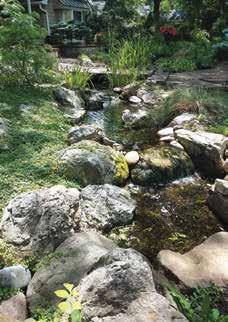
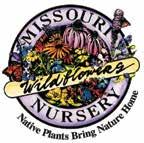

573-496-3492, fax: 573-496-3003 www.mowildflowers.net mowldflrs@socket.net 9814 Pleasant Hill Rd Jefferson City MO 65109
Meet us at one of these locations in the KC area. Give us your order at least 5 days before a sale, and we will bring it to the location.
Deep Roots Native Plant Sale at Anita B. Gorman Conservation Discovery Center, 4750 Troost Ave, KC MO 64110. May 10, 10 a.m. to 2 p.m. deeprootskc.org
Missouri Prairie Foundation Native Plant Sale at Anita B. Gorman Conservation Discovery Center, 4750 Troost Ave, Kansas City MO 64110. Saturday, May 17, 10 a.m. to 2 p.m.
Deep Roots Native Plant Sale at Anita B. Gorman Conservation Discovery Center, 4750 Troost Ave, KC MO 64110. June 14, 10 a.m. to 2 p.m. deeprootskc.org
DAY TRIP! The Nursery is open year round at our Brazito location (address above), 9 to 5 weekdays, and weekends now through July 6, then Aug. 30 through Oct. 12.
At the Nursery only quart pots are $6.95 and small pots are $3.50, if you pick the plants.
Douglas County Extension
Master Gardeners invite you to two special events you won’t want to miss. First, the Native Plant Sale will be held on Saturday, May 31 from 9 a.m. to 1 p.m. in the Open Pavilion at the Douglas County Fairgrounds at 2120 Harper in Lawrence. We have more than doubled our inventory of plants grown locally without pesticides. Buy one plant for $5 or three plants for $14 in person and/or order six choices of bloom boxes online from May 1 through May 27 at dgemgks.org.
On the following weekend, the Garden Tour will be held on Saturday, June 7 from 10 a.m. to 5 p.m., and on Sunday, June 8, from 11 a.m. to 5 p.m. Purchase tickets for $15 online (ages 9 and under free) at dgemgks.org or in person (cash or check only) on tour days at the Douglas County Fairgrounds at 2110 Harper.
Douglas County Demonstration Gardens
While at the Fairgrounds, stroll through 16 themed beds designed to inform and provide you with gardening ideas. Experienced volunteers will be on hand to answer your questions. Then tour six unique gardens with inspirational landscapes.
Ernie Eck and Tricia Karlin have maintained the visual integrity of their historic 1870 home with a beautifully designed front landscape. A stunning variety of conifer shrubs are configured among rocks along with colorful perennials and shrubs, textural grasses, and small trees for four-season interest. The backyard features a large bermed pond with more conifers, flowering shrubs, and a mature Japanese maple tree.

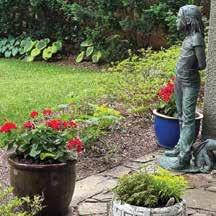
Larry and Kassie Nieters have been curating their striking front landscape designed by the previous owners. Colors pop from flowering perennials and shrubs along the brick sidewalk and easement among richly green shade plants. Past the gate, enjoy Asian-themed areas and relax in the backyard oasis with its four-season pond of perennials and annuals.
The backyard of Richard Glor’s historic home features home-made raised beds chock full of colorful cutting flowers behind two living fences of vining perennials. Two varieties each of apples, peaches, and cherries comprise his urban orchard. Tall native perennials and majestic cup plants round out other beds.
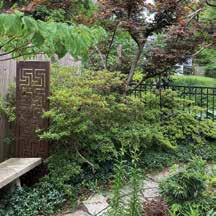
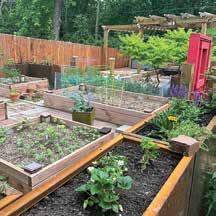
As an accomplished sculptor, Lori Norwood follows her artistic whims (and the sun) by creating “vignettes” in stone-lined garden beds. In the partially shaded backyard, flowering perennials and shrubs thrive in patches of sunlight with colorful annuals situated in containers. Half of the sunny front yard features large flowering shrubs and native perennials along the easement.
Anna Kimbrell, the gardener, and Adam Handshy, the builder, have created “whimsical chaos” in their front and backyards. A wide variety of flowering shrubs, native and nonnative perennials, vines, grasses, and trees provide vibrant colors, contrasting textures, and focal points for
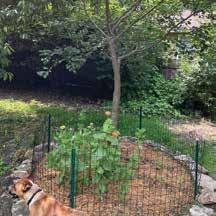
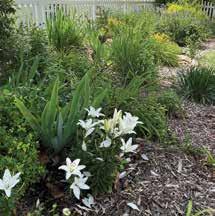
seasonal interest. In the backyard, vegetables and herbs thrive in raised beds next to entertainment areas.
After Ed and Ronda Schulte moved to their new home on a two-acre lot north of Baldwin City, they created a “prairie paradise” for beauty, peace, and joy. This expansive landscape, designed in circles, squares, and rectangles, showcases multiple themed gardens with roses, shrubs, trees, and hundreds of assorted perennials. Their red barn has an extended patio, a garden work bench, and an old sink for washing vegetables nearby. A great view of the neighbor’s lake lies past children’s play areas.
Learn more at dgemgks.org

~ Welcome to a Gardener’s Paradise ~ It’s not spring without a trip to Arnold’s Prairie!
Come enjoy a day in the country, shopping our huge greenhouse full of our expansive selection of Annuals, Perennials, Veggies & Herbs, as well as Shrubs, Trees, Houseplants, Supplies & More!


1430 Hwy. 58 info@arnoldsgreenhouse.com. Sun. 1 - 5 pm.
Please Note: CLOSED Sunday May 11th for Mother’s Day and Monday 26th for Memorial Day. Thank you! ~ Follow us on Facebook for all the Latest News & Specials ~
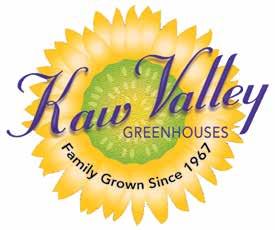

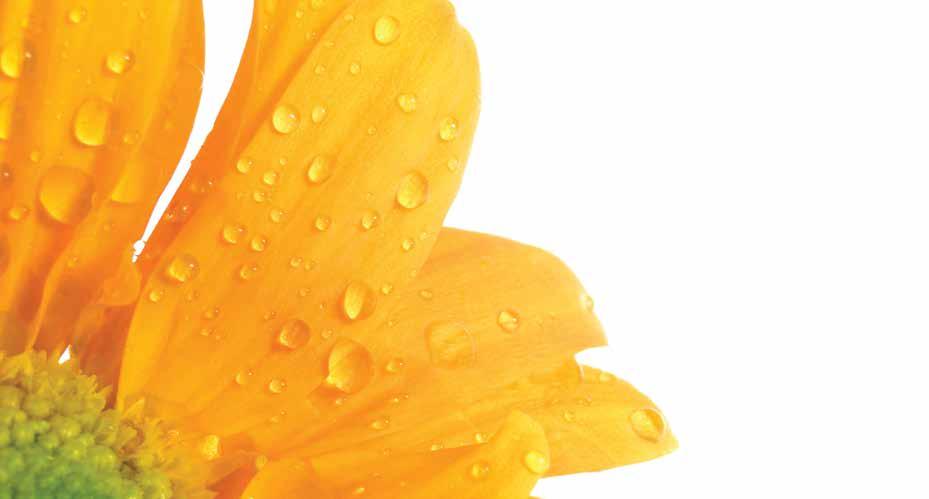
• Price Chopper, 120 E 19th St TOPEKA • Topeka Mall, 1801 SW Wanamaker • 200 NE US 24 & Frontage Rd
BLUE
• Price Chopper, 1305 N Hwy 7 COLUMBIA • Columbia Mall, 2300 Bernadette Dr KANSAS CITY • Hy-Vee (Barry Rd), 8301 N St Clair Ave
KEARNEY • Price Chopper, 701 Watson Dr
LEE’S SUMMIT • Price Chopper, 251 SW Greenwich Dr
JOSEPH • Hy-Vee, 201 N Belt Hwy
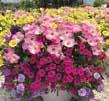




Garden Club of Shawnee
Thurs, May 1, 7p; at Shawnee Town 1927’s Town Hall, 11600 Johnson Dr, Shawnee, KS. KState Extension Master Gardener Jen Stefanchik will talk to us about “Gardening with Herbs.” This will be our spring plant, seed and bulb exchange. As always, visitors are welcome. Please visit our website gardenclubofshawnee.org and our Facebook page for more information.
Kansas City Cactus and Succulent Society
Sun, May 18, 1:30-3:30p; at Trailside Center, 9901 Holmes Rd, Kansas City, MO. We will learn the procedures and prep guidelines for submitting our plants in a judged show and in the various categories with which to enter our plants. How to use the best pot, proper botanical name labeling and top dressing a plant for its best look is important. Discussion of how a judged show works, especially for newcomers who are first time participants, will be described. Refreshments will be served and everyone is invited to attend.
Leavenworth County Master Gardeners
Wed, May 14, 11a; at Riverfront Community Center, 123 Esplanade St, Leavenworth, KS 66048. Rick Spurgeon, tree expert and forester, will share Stories of the Champion Trees of Kansas. Discussion will include information on identifying, measuring and the splendor of a champion tree. The meeting is free. Visitors are welcome. For more info contact Leavenworth County Extension office at 913-364-5700.
Raytown Garden Club
Tues, May 6, 10a; at Connection Point Church, 10500 E 350 Hwy, Raytown, MO 64138. Program will be “Shade Gardening to Enhance Our Earth”, presented by Sherri Carter, Master Gardeners Speakers Bureau. Guests are always welcome. For more information please check out our Facebook page: https://www.facebook. com/RaytownGardenClub.
Wyandotte Co EMG Plant Sale
Fri, May 2, 9a-5p and Sat, May 3, 9a-2p; at the Wildcat Room of the Extension Office, 1200 N 79th St, Kansas City, KS. The Wyandotte County Extension Master Gardeners will be conducting their annual plant sale. There will be vegetables, herbs, perennials, berries, ornamental grasses and more grown by the EMGs. Proceeds fund the EMG educational programming. Cash, checks, and debit and credit cards accepted. 913-299-9300.
Garden Treasures Sale
May 2 and 3, 9a-5p; at 12201 Aberdeen Rd, Leawood, KS. Plants, pots, tools, decor and FREE hot dogs. A Faith Missions benefit for women and children in Rwanda and Uganda.
Liberty’s Town and Country Garden Club Annual Plant Share
Sat, May 3, 8a-noon; at Rotary Plaza, downtown Liberty (100 W Franklin). We invite you to stop by for free garden plants and share your own if you wish. No early birds please.
Platte County MG Plant Sale
Sat, May 3, 10a-3p and Sun, May 4, Noon-3p; in the Greenhouse located at the Northland Career Center, 1801 Branch St, Platte City, MO 64079. This 1st annual plant sale will offer a variety of perennials, natives, annuals and herbs. The sale happens rain or shine. Proceeds benefit the MU Extension Master Gardeners of Platte County. www.plattecountymastergardeners.org; plattemgs@gmail.com
Olathe Garden Club’s Annual Plant Sale
Tues, May 6, 4-7:00p, Wed, May 7, 8a-12p; at 18505 W 114th St, Olathe, KS 66061. Come get some great new plants for your outdoor and indoor spaces while helping us raise money. This is our annual fundraiser for all of our philanthropic and educational activities throughout the year! *Credit & Electronic Payments Accepted in addition to cash/check!* You may find perennials, annuals, herbs, vegetables, flowers, pollinator-friendly plants, shade plants, sun-loving plants, house plants, and artisan-made garden decor! Come meet the members of Kansas’ oldest garden club; established in 1929. Plant love and knowledge will be freely shared!
Spring Iris Show
Sat, May 10, Set up and entries: 8a, Judging starting 10:30a, Iris Show 12-4p; at the Social Hall in Colonial Church, 7039 Mission Rd, Prairie Village, KS. Presented by Greater Kansas City Iris Society. Anyone may enter the Horticultural Division, with the correct AIS approved name of a variety. Artistic arrangements can entered using unnamed iris as the dominant flower(s) in the design. For complete Show Schedule, please contact Carolyn Ash at Carolyn.Ash7@gmail. com. Mark your calendars for our Public Iris Sale, Aug 23, at the same location.
Spring Open House & Plant Fundraiser Sat, May 10, 8a-2p; at Monarch Watch, KU West Campus, Lawrence, KS. https://monarchwatch.org/events. We will have thousands of plants available, and all are ideal for starting butterfly gardens or adding to established gardens and can contribute to the health of monarch and pollinator populations. Our Spring Open House & Plant Fundraiser will be primarily an outdoor event, and there will be tours of our gardens, games, activities, monarch butterflies, caterpillars, and lots of butterfly plants for your own garden! Online ordering of plants will be available in advance (mid-April), and details will be posted soon.
Free Family Fun: Miami County Farm Tour Showcases Local Agriculture May 10-11. Discover the heart of Eastern Kan-
sas agriculture during the free Miami County Farm Tour. This self-guided tour invites visitors to explore 12 diverse farms, offering hands-on educational experiences and a glimpse into rural life amidst the county’s scenic beauty. Although this event is child friendly, each site is a working farm. Visitors are asked to encourage to respect for the farm’s operations, plants and animals. Pets should be left at home. For more information about the farm tour or to receive a map of the sites please call 913-294-4045. www.MiCoFarmTour.com
Discover The Beauty of Historic Rockhill— Garden & Architecture Tour Sat, May 17, 10a-4p. The Rockhill neighborhood is celebrating its Golden Jubilee. It’s been 50 years since Rockhill was designated an historic district and 125 years since William Rockhill Nelson developed the neighborhood. This is a walking tour* featuring over 35 homes of architectural interest and entrance into 8 beautiful gardens. Each ticket entitles you to a tour bracelet for garden entrance and a 32-page full color brochure filled with history, architecture, garden information and a map of the tour. Master Gardeners of Greater Kansas City will be providing EMG volunteers to help visitors with the tour. Volunteers at the Public Relations Table will also be presenting information on MGGKC programs. *People with disabilities may park in the neighborhood. The Rockhill neighborhood is located just east of the Nelson-Atkins Museum of Art. Parking will be available in the lot of the Ewing and Muriel Kauffman Memorial Garden at 4800 Rockhill Rd. The Welcome Tent will be across from the parking lot at 532 Pierce St. Purchase tickets at https://rhgctour.com.
Lee’s Summit Farmers Market Saturdays, May 17, 24 and 31, 7:30a-12p. Master Gardeners of Greater Kansas City will be at Lee’s Summit Farmers Market, with the Public Relations Table, presenting programs on pollinators and IPM/cultural controls. Extension Master Gardeners will also be promoting The MGGKC Garden Tour and selling tickets. Free to the public, children under 16 welcome when accompanied by an adult. Public Parking Lot at corner of Second and Douglas Streets, Lee’s Summit, MO.
Native Plant Sale
Sat, May 17, 10a-2p; at Anita B Gorman Conservation Discovery Center, 4750 Troost Ave, Kansas City, MO 64110. Missouri Prairie Foundation
Fourth Fridays Art Walk Fri, May 23, 5-8p; Downtown Lee’s Summit, near the intersection of Southwest Third St and Southwest Main St, Lee’s Summit, MO 64081. Downtown Lee’s Summit Main Street presents Fourth Fridays Art Walk. The Art Walk showcases local artists, live music performances, along with participating shops and restaurants. The theme for May is “Art Grows Here.” The
Master Gardeners of Greater Kansas City will provide a Children’s Activity called “Plant Parts” with vegetable art printing. The Gardens of Unity Village will provide the produce for this art activity. The Hotline and “Helping You Learn to Grow” brochures will be available for adults. Free to the public. Children are welcome with adult supervision.
Native Plant Sale
Sat, May 24, 8a-noon; at Lenexa Farmers Market, 17201 W 87th St Pkwy, Lenexa, KS 66219. Discover a vibrant variety of landscaping options. Browse grasses, flowers, and other plants from local vendors. lenexa.com/nativeplantsale.
African Violet Show and Sale
Fri, May 30, 9a-5p, and Sat, May 31, 9a-3p; at DoubleTree by Hilton Kansas City-Overland Park, 10100 College Blvd. The African Violet Society of America is holding its 79th annual convention show and sale. The show and sales room is open to the public, $5 admission fee. Find varieties not available to the public at this event! africanvioletsocietyofamerica.org.
Kansas City Rose Show
Sat, May 31; at Loose Park Garden Center. Free and open to all rose gardeners with assistance provided for first-time exhibitors. Classes for live blooms and rose photographs. Entries accepted from 8-11am. Visit https://www.kansascityrosesociety.org for the show handbook with class lists and show rules. Also find links to tips on how to grow and show prize-winning roses.
Kansas City Rose Day
Sun, Jun 1, 1-4p; at Laura Conyers Smith Rose Garden in Loose Park. View the results of the Rose Show in the Garden Center with hundreds of blue-ribbon winners and gleaming trophies. In the garden, enjoy family activities, live entertainment, and an afternoon of beauty in this world-renowned rose garden. Free to everyone. Visit www.kansascityrosesociety.org for further information.
Fox Hollow Festival
Sun, Jun 1, 12-5p (12-2:30p for MGGKC activities); at Lakeside Nature Center, 4701 East Gregory Blvd, Kansas City, MO 64132. Master Gardeners of Greater Kansas City Children’s Programs will be presenting “Pollinators: Not Just Bees and Butterflies.” Children can learn about other living and non-living ways plants are pollinated, and discover these pollinators work by day and night. There will be an experiment using an insect to pollinate paper flowers and learn ways to help pollinators in their own home and community. MGGKC activities will be 12-2:30p. From 2:30 to 5p, enjoy festival activities such as food trucks, live music, and adult beverages. For more info visit https://lakesidenaturecenter.org/event/fox-hollow-fest-2/
MGGKC Garden Tour
Jun 6 and 7, 9a-4p; Lee’s Summit. Join MU
Extension Master Gardeners of Greater Kansas City (MGGKC) for our 2025 Garden Tour. Featuring 7 beautiful gardens in Lee’s Summit. The gardens—Viva Vegetables, Naturally Natives, Tree Tales, Cul-de-Sac Creations, Suburban Sanctuary, Lakeside Lessons, and Artistic Designs—provide unique experiences to delight both experienced and novice gardeners. Visitors will be inspired by the blending of art, native plants, vegetables mingled with traditional plantings, environmentally friendly gardening practices, secluded spaces, and plant specimens not always seen in residential settings. Tickets are $20 per person (children 12 and under attend free of charge) and can be bought online, in person, and at select retailers. For online tickets please find the following link: https://form. jotform.com/250194247684059. Tickets may be picked up at the “Will Call” table at Garden 1, Viva Vegetables. The address for Viva Vegetables “Will Call” will be included with your purchase receipt. On-site purchases at Garden 1, Viva Vegetables, can be made using cash, credit, debit, or check. Please visit mggkc.org/our-projects/garden-tour/ for complete details.
Heartland Hosta & Shade Plant Society Annual Spring Plant Sale
Sat, Jun 7, 9am-2pm; at Woods Chapel Community of Christ Church, 500 NE Woods Chapel Rd, Lee’s Summit, MO 64064. The sale features over 1200 plants including 68 varieties of Hosta and plenty of shade/part shade perennials! Prices start at $10 and we have all sizes of Hosta from mini to giant to suit all size gardens. This sale is open to the public. Sale list with pictures and descriptions will be available on the club website prior to the sale. For more information please visit www.HeartlandHosta.club or the Facebook page www.Facebook.com/HeartlandHostaandShadePlantSociety/.
Northeastern Kansas Beekeepers Association Funday Expo
Sat, Jun 7, 8a-6p; at Douglas County Fairgrounds, Lawrence, KS, 2120 Harper St, Lawrence, KS 66046. Funday is an exciting annual event for beekeepers in the Midwest. This fun learning opportunity is for beekeepers with all levels of experience. There will be national and local speakers, a swarm demo with a bee beard competition, a marking the queen activity, inhive demos, honey and wax workshops. Sessions include gardening for wildlife, designing a honey house, winter preparations, and swarm management. Also included is lunch, honey ice cream, vendors, silent auction, and more. There will also be a queen rearing workshop for the first 25 participants to contact Joli Winer at 913-593-3562. New this year is a photography contest and decorative hive painting competition. To learn more and to register visit www. nekba.org.
Garden Sampler Tour Sat, Jun 14, 9a-5p, Rain or Shine. Got the winter blahs? Already scanning the seed cata-
logs for the newest plants? Save the Date of June 14 for the ever-popular, Garden Club of Shawnee’s Garden Sampler Tour. Visit https:// gardenclubofshawnee.org for latest information regarding Club and tour event.
Grow Your Knowledge: Gardening Tips & Hands-On Fun for Kids!
Sat, Jun 14, 8-11:30a; at The Gardens at Unity Village, 150 B Colbern Rd, Lee’s Summit, MO. Step into a century of history and nostalgia at The Gardens at Unity Village Produce Market. Nestled behind the iconic three-story barn, three cultivated acres yield a bounty of freshly harvested fruits and vegetables. Volunteers from the Master Gardeners of Greater Kansas City will be on hand to share expert, research-based gardening knowledge with the community. Children can take part in a hands-on educational activity, discovering the wonders of gardening and plant life. This free event welcomes all ages, and no registration is required.
Produce Market at The Gardens at Unity Village
Sat, Jun 14, 8-11:30a; at Unity Village, 150B Northwest Colbern Rd, Lee’s Summit, MO 64086. Step into a century of history and nostalgia at The Gardens at Unity Village Produce Market. Nestled behind the iconic three-story barn, three cultivated acres yield a bounty of freshly harvested fruits and vegetables. Volunteers from the Master Gardeners of Greater Kansas City will be on hand to share expert, research-based gardening knowledge with the community. Children can take part in a handson educational activity, discovering the wonders of gardening and plant life. This free event welcomes all ages, and no registration is required.
Garden Railroad Tour
Sat, Jul 12, 8a-4p; Sat, Jul 26, 8a-4p; and Sat, Aug 23, 8a-4p. Adults and kids are invited to tour a variety of unique train gardens at homes in the greater Kansas City area. They are like a miniature world with model trains running through garden landscaping, with small houses and buildings, trees, plants, water features, bridges and tunnels. The admission for this selfguided tour is $10 per car which includes seeing all the gardens on tour. The host, MO-KAN Garden Railroaders will donate 50 percent of the proceeds to Harvesters. For tickets and tour guide, go to www.mokangardenrailroaders.org.
Miami County Fall Garden Tour
Sep 5-6, 9a-5p. Five unique country gardens, rain or shine. “A September to Remember”. Sponsored by K-State Research and Extension Master Gardeners, 913-294-4306.
Wake Up Your Garden Sat, May 3, 9-11a; at Burr Oak Woods Nature Center, 1401 Northwest Park Rd, Blue Springs, MO 64015. Time to shake off Winter’s final
cold grip and wake up our garden beds! Burr Oak Woods Nature Center’s “Wake Up Your Garden” Work and Learn, will feature a cleanup of last year’s old growth while uncovering and identifying our Spring seedlings. All hand tools and gloves will be provided; however, participants are welcome to bring their own. Water will be available onsite, but please bring a water bottle. Learning objectives will include identifying spring ephemerals, telling the difference between a weed and an intentionally planted species, and learning common garden maintenance practices for spring. Registration is required and participants must be 18 or older. There is a maximum number of 20 participants. The sign-up is available at Events | Missouri Department of Conservation. Questions? Contact Burr Oak Woods, phone 816.228.3766, or email jada.tressler@mdc.mo.gov.
Bucket Gardening in Small Spaces Thurs, May 8, 6:30p; at Basehor Community Library, 1400 158th St, Basehor, KS 66007. Have you always wanted a garden but have been limited on space or time? Bucket gardening is a great way to grow your favorite herbs and veggies with a minimal amount of space and effort. Growing in buckets also keeps weeds and pests to a minimum. Just water regularly and make sure your buckets are in a sunny location. You can harvest your crops all the way to the first frost for many types of plants. Come to our presentation with Master Gardener, Dianne Scott, to learn how to set up your own bucket garden. The meeting is free. Visitors are welcome. For more information contact the Leavenworth County Extension office at 913-364-5700.
Gardens of Slavery in the American South Thurs, May 8, 11:30a; at the Wy Co Extension Office, Sunflower Room, 1208 N 79th Street, Kansas City, KS. Presented by Alleen Van Bebber, Johnson County Extension Master Gardener. Much has been known and written about the urban and plantation gardens of landowners in the Colonies and then in the southern states before the Civil War. But recently our popular national attention has been turned to the personal gardens of slaves in the American South. New articles, books, and especially cookbooks, are now readily available, many of them written by people of color who are exploring and honoring their own heritages.This presentation is limited to discussing the gardening lives of slaves in the rural south between the 1600s and the Civil War, as described by those who lived in those times. Much of the historical record was set down by slaveholders and visiting writers, but the record also was made by slaves who could read and write, along with white people who were indentured servants and often were treated as slaves. It is a rich and varied record, and it tells us much about gardening for survival, as well as the universal love of gardening shared by people of all social and economic status in every generation, time, and place. From Colonial plots to the Victory Gardens of both World Wars, it was
not just varying soil types and weather that dictated how we built our rural and urban gardens. She is fascinated by the cultural and societal differences that made America’s home gardens look so different in different times or places. She hopes others will enjoy mind-traveling, and maybe some will even replicate a historic garden of their own. She will include showing how to draw maps! Alleen’s gardening habit started as a fifth-generation SE Kansas farm girl. She has lived, practiced law, and gardened in Johnson County for 35 years and became a Johnson County EMG in 1998. Pre-registration is not required. A $10 class fee (cash or check) will be collected at the door. Questions can be directed to 913-299-9300.
Bearded Iris - The Basics
Thurs, May 15, 7p; at Leavenworth Public Llibrary, 417 Spruce St, Leavenworth, KS 66048. Leavenworth County Master Gardeners Diana Thurlow and Dana Joras will provide information about growing bearded iris, including the benefits of having these beautiful flowers in your garden beds and how to care for the plants. Discussion will include how and when to plant and divide iris so they multiply and produce blooms year after year, as well as information on local iris resources. Iris specimens will be on display. The class is free and open to the public. For more information contact the Leavenworth County Extension office at 913-364-5700.
Summer Youth Gardening Program
Univ of Missouri Extension Master Gardeners of Greater Kansas City is conducting a summer gardening program for youth ages 9-13. In the Garden ‘N Grow Program, youths learn not only vegetable gardening, but also “cultivate” other science, math, and language arts skills and have fun! The goals of this program are to experience the fun of gardening, to enjoy a feeling of success, and to have the satisfaction of sharing harvested food with family and/or local food banks. Program will be held on Mondays and Thursdays from 9-11a, from Jun 2 thru Aug 14 at Fairview Christian in Gladstone. Registration is required—NO Walk-ins. There is a supply fee of $45 payable by check or cash at the first week of Garden N Grow. For more information contact Debbie Johnson, Extension Master Gardener at djw603@gmail.com or Cass Sullivan, Extension Master Gardener at cass.sullivan301@ gmail.com.
List garden events like classes, workshops, club meetings, and plant sales for FREE!
Send details to elizabeth@kcgmag.com Deadline for the June issue is May 5.

• Verticut or core aerate Zoysia to reduce thatch layer.
• Sod or sprig bare areas of Zoysia.
• Fertilize Zoysia with a high-nitrogen product to promote green-up and summer growth.
• Mow Zoysia at 2 inches tall.
• Spot treat broadleaf weeds on a day without wind.
• Apply a slow-release fertilizer to bluegrass and tall fescue if watering during the summer.
• Mow bluegrass and tall fescue at 3 to 3 ½ inches.
• Withhold early summer watering until needed to promote more drought-tolerant lawns.
• Let grass clippings fall to return needed nutrients to the turf.
• Keep the mower blade sharp for a clean cut.
• Don’t blow grass clippings into the street. Discharge back onto the lawn to keep our streams clean.
• Plant tomato, pepper, and eggplant transplants in early to mid-May.
• Seed sweet corn, cucumbers, squash, beans, and other warm-season vegetables.
• Cultivate soil lightly with a hoe to control weed growth.
• Mound soil around potato plants to encourage tuber formation.
• Harvest fresh asparagus until the spear size decreases.
• Remove rhubarb seed stalks to promote leaf growth.
• Plant kitchen herbs for summer use.
• Harvest salad crops and enjoy.
• Keep broccoli, cauliflower, and cabbage well fertilized for big yields.
• Treat fruit trees with needed pesticides to manage insects and diseases.
• Thin dense fruit set on apples and peaches to increase fruit size and next year’s crop.

• Plant new trees and shrubs.
• Prune spring flowering shrubs after bloom to shape the plant and encourage flowers next year.
• Mulch around young trees and shrubs to conserve moisture and control weed growth.
• Water young ornamentals as needed.
• Remove tree wraps for summer growth.
• Remove tree stakes in place for more than one growing season.
• Fertilize trees to help increase growth rates.
• Use caution with line trimmers around trees and shrubs so as not to damage tender bark.
• Plant annual flowers for summer color.
• Continue to plant and divide perennials.
• Mulch perennial and annual gardens for weed control and moisture retention.
• Begin pinching chrysanthemums for bushier plants.
• Allow foliage from spring bulbs to stay until it dies down naturally. This develops stronger blooms for next year.
• Plant container gardens and hanging baskets using a good quality potting mix.
• Move plants outdoors for summer by gradually increasing exposure.
• Fertilize plants to promote summer development.
• Rotate plants to develop a well-rounded plant.
• Wash dusty leaves in the shower under room temperature water.
• Start new plants with 4 to 6-inch cuttings.
• Repot plants into a 1-inch larger pot.
• Check for insects.
Johnson County K-State Research and Extension recommends environmentally-friendly gardening practices. This starts by identifying and monitoring problems. Cultural practices and controls are the best approach for a healthy garden. If needed, use physical, biological or chemical controls. Always consider the least toxic approach first. Markis Hill is the horticulture agent for Johnson County K-State Research and Extension. For free information fact sheets, visit www.johnson.ksu.edu, or call the Extension office at 913-715-7000.
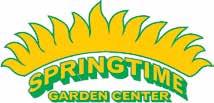
1601 NE Tudor Rd. Lee’s Summit, MO (816) 525-4226
MOTHER’S DAY WEEK SALES!
May 5 – 11, 2025
Beautiful Hanging Baskets, Fountains, Statuary, Pots, Blooming Shrubs A Week full of giveaways. Mention this ad!


Ferti-lome High Performance Container Mix is a high quality potting soil with no wood fillers and nutrient dense fertilizer that can last up to 6 months
Ferti-lome Weed-Out is available in liquid, perfect for spot control, and granular which is the 2nd step in the 5 step lawn program we recommend for a beautiful and healthy, weed-free lawn
Ferti-lome Blooming & Rooting is a highly concentrated plant food that is ideal for all blooming plants






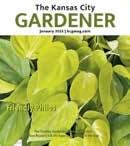
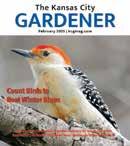
Extension Master Gardeners are ready to answer all your gardening questions.
CASS COUNTY
816-380-8194; Wed, 9am-noon; casscomg@gmail.com
DOUGLAS COUNTY
785-843-7058; dgcogardenhotline@gmail.com; Mon, Wed, Fri, 1-4pm
GREATER KANSAS CITY MISSOURI AREA
816-833-8733 (TREE); Mon-Fri, 9am-noon; mggkc.hotline@gmail.com
JOHNSON COUNTY, KS
913-715-7050; Mon-Fri, 9am-4pm; garden.help@jocogov.org
JOHNSON COUNTY, MO
660-747-3193; Wed, 9am-noon
LEAVENWORTH COUNTY
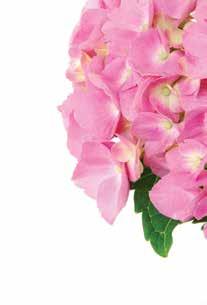
913-364-5700; Leave a message. A Master Gardener will contact you.
MIAMI COUNTY & LINN COUNTY
913-294-4306; Thurs, 8am-noon
WYANDOTTE COUNTY
913-299-9300; Mon-Fri, 9am-4pm
QUESTIONS ABOUT ROSES?
Ask a Rosarian; rosehelp@kcrosesociety.org; www.kansascityrosesociety.org
For convenient mail delivery, complete the form below and send with your check for $38.00. You will receive a one-year subscription.



